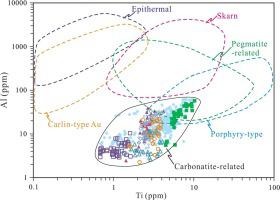Ore Geology Reviews ( IF 3.3 ) Pub Date : 2022-08-22 , DOI: 10.1016/j.oregeorev.2022.105068 Wei Zhang, Wei Terry Chen, Xing-Chun Zhang, Yan-Wen Tang

|
Quartz is a common gangue mineral in many magmatic-hydrothermal ore deposits (e.g., porphyry, epithermal and skarn deposits) and its trace element composition was widely used to constrain ore genesis. Quartz is also a common phase in carbonatite-related rare earth element (REE) deposits, but its geochemical characteristics and significance for ore genesis have not previously been documented in this environment. In this contribution, we report in-situ LA-ICP-MS trace element compositions of quartz from seven carbonatite-related REE deposits, namely the Maoniuping, Lizhuang and Dalucao deposits in the Mianning-Dechang REE metallogenic belt, SW China and the Miaoya, Taipingzhen, Huangshuian and Huanglongpu deposits in the Qinling REE metallogenic belt, Central China. Rare earth element mineralization in these deposits is associated with well-developed hydrothermal systems in which the dominant REE minerals, bastnäsite, parisite, and monazite, are intergrown with aegirine-augite, arfvedsonite, calcite, fluorite, barite, and quartz. The results show that quartz grains from the carbonatite-related REE deposits are characterized by low budgets of trace elements, of which Al is generally less than 50 ppm whereas others are generally less than 10 ppm. In general, the trace element concentrations in quartz from different deposits are similar (the total concentration is commonly <50 ppm), and are distinguishable from those of quartz in other magmatic-hydrothermal systems. The low concentration of trace elements in carbonatite-related REE deposits is controlled by the unusual nature of carbonatitic magmas and their derived fluids, and thus can be used for defining the affinity of hydrothermal REE systems that are of unknown origin. Significantly, the trace element chemistry of quartz samples collected from a cross-section in the open pit of the Maoniuping REE deposit displays a systematic spatial variation such that the concentrations of Al, Ti, Na, and K decrease with increasing distance of the samples from carbonatites. This spatial variation correlates well with the variation of physio-chemical conditions during the evolution of ore-forming fluids. This implies that the geochemistry of quartz can be used as a vector detecting the concealed carbonatite intrusions in carbonatite-related REE deposits.

























 京公网安备 11010802027423号
京公网安备 11010802027423号